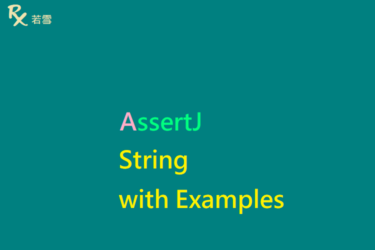Table of Contents
ToggleJava TreeMap Methods
不允許儲存空鍵,但可以儲存空值,提供自訂 Comparator 依照鍵排序,介紹常見的 put 、 get 、 clear 、 size 等方法,將資料存儲在鍵、值對中,可以通過另一種類型的索引訪問,當插入重複鍵時,會替換相應鍵的元素, TreeMap Java Methods 本篇增加了範例,並透過單元測試來驗證產出結果。
檔案目錄
./
+- src
+- test
| +- org
| +- ruoxue
| +- java_147
| +- map
| +- treemap
| +- TreeMapMethodsTest.java 單元測試
TreeMap Java Methods 提供新增、取得、修改、刪除等操作 Map 中的元素。
Fruit
TreeMap Methods Java 建立 Fruit 物件,覆寫 equals 、 hashCode ,定義屬性和方法,用來建立一個物件。
@NoArgsConstructor
@Getter
@Setter
@Builder
public static class Fruit implements Comparable<Fruit> {
private String name;
private double quantity;
private int type;
public Fruit(String name, double quantity, int type) {
this.name = name;
this.quantity = quantity;
this.type = type;
}
public String toString() {
ToStringBuilder builder = new ToStringBuilder(this, ToStringStyle.JSON_STYLE);
builder.appendSuper(super.toString());
builder.append("name", name);
builder.append("quantity", quantity);
builder.append("type", type);
return builder.toString();
}
public boolean equals(Object object) {
if (!(object instanceof Fruit)) {
return false;
}
if (this == object) {
return true;
}
Fruit other = (Fruit) object;
return new EqualsBuilder().append(getName(), other.getName()).isEquals();
}
public int hashCode() {
return new HashCodeBuilder().append(getName()).toHashCode();
}
@Override
public int compareTo(Fruit o) {
return this.name.compareTo(o.name);
}
}put
TreeMap Methods Java 建立一個 TreeMap ,增加三個元素。
@Test
public void put() {
int expectedSize = 3;
Map<Fruit, Integer> map = new TreeMap<>();
map.put(new Fruit("Grape", 1, 1), 1);
map.put(new Fruit("Lemon", 3, 1), 3);
map.put(new Fruit("Kiwifruit", 2, 1), 2);
System.out.println(map);
assertEquals(expectedSize, map.size());
}{{"name":"Grape","quantity":1.0,"type":1}=1, {"name":"Kiwifruit","quantity":2.0,"type":1}=2, {"name":"Lemon","quantity":3.0,"type":1}=3}putIfAbsent
TreeMap Methods Java 建立一個 TreeMap ,當元素不存在時,新增元素。
@Test
public void putIfAbsent() {
int expectedSize = 3;
Map<Fruit, Integer> map = new TreeMap<>();
map.put(new Fruit("Grape", 1, 1), 1);
Integer put = map.putIfAbsent(new Fruit("Lemon", 3, 1), 3);
System.out.println(put);
assertNull(put);
map.put(new Fruit("Kiwifruit", 2, 1), 2);
System.out.println(map);
assertEquals(expectedSize, map.size());
}null
{{"name":"Grape","quantity":1.0,"type":1}=1, {"name":"Kiwifruit","quantity":2.0,"type":1}=2, {"name":"Lemon","quantity":3.0,"type":1}=3}
get
TreeMap Methods Java 建立一個 TreeMap ,內有三個元素,取得指定 Key 元素。
@Test
public void get() {
Integer expected = 2;
Map<Fruit, Integer> map = new TreeMap<>();
map.put(new Fruit("Grape", 1, 1), 1);
map.put(new Fruit("Lemon", 3, 1), 3);
Fruit key = new Fruit("Kiwifruit", 2, 1);
map.put(key, 2);
Integer value = map.get(key);
System.out.println(value);
assertEquals(expected, value);
}2getOrDefault
TreeMap Methods in Java 建立一個 TreeMap ,內有三個元素,取得指定 Key 元素,若不存在傳回預設值。
@Test
public void getOrDefault() {
Map<Fruit, Integer> map = new TreeMap<>();
map.put(new Fruit("Grape", 1, 1), 1);
map.put(new Fruit("Lemon", 3, 1), 3);
map.put(new Fruit("Kiwifruit", 2, 1), 2);
Integer result = map.getOrDefault(new Fruit("Empty", 0, 0), new Integer(10));
System.out.println(result);
assertNotNull(result);
}10update
TreeMap Methods in Java 建立一個 TreeMap ,內有三個元素,更新指定 Key 元素。
@Test
public void update() {
Integer expected = 10;
Map<Fruit, Integer> map = new TreeMap<>();
Fruit key = new Fruit("Grape", 1, 1);
map.put(key, 1);
map.put(new Fruit("Lemon", 3, 1), 3);
map.put(new Fruit("Kiwifruit", 2, 1), 2);
System.out.println(map);
Integer put = map.put(key, new Integer(10));
assertEquals(1, put.intValue());
System.out.println(map);
assertEquals(expected, map.get(key));
}{{"name":"Grape","quantity":1.0,"type":1}=1, {"name":"Kiwifruit","quantity":2.0,"type":1}=2, {"name":"Lemon","quantity":3.0,"type":1}=3}
{{"name":"Grape","quantity":1.0,"type":1}=10, {"name":"Kiwifruit","quantity":2.0,"type":1}=2, {"name":"Lemon","quantity":3.0,"type":1}=3}
remove
TreeMap Methods in Java 建立一個 TreeMap ,內有三個元素,刪除指定 Key 元素。
@Test
public void remove() {
int expectedSize = 2;
Map<Fruit, Integer> map = new TreeMap<>();
Fruit key = new Fruit("Grape", 1, 1);
map.put(key, 1);
map.put(new Fruit("Lemon", 3, 1), 3);
map.put(new Fruit("Kiwifruit", 2, 1), 2);
map.remove(key);
System.out.println(map);
assertEquals(expectedSize, map.size());
}{{"name":"Kiwifruit","quantity":2.0,"type":1}=2, {"name":"Lemon","quantity":3.0,"type":1}=3}clear
TreeMap Methods in Java 建立一個 TreeMap ,內有三個元素,刪除所有元素。
@Test
public void clear() {
int expectedSize = 0;
Map<Fruit, Integer> map = new TreeMap<>();
map.put(new Fruit("Grape", 1, 1), 1);
map.put(new Fruit("Lemon", 3, 1), 3);
map.put(new Fruit("Kiwifruit", 2, 1), 2);
map.clear();
System.out.println(map);
assertEquals(expectedSize, map.size());
}{}size
TreeMap Methods in Java 建立一個 TreeMap ,內有三個元素,取得長度。
@Test
public void size() {
int expectedSize = 3;
Map<Fruit, Integer> map = new TreeMap<>();
map.put(new Fruit("Grape", 1, 1), 1);
map.put(new Fruit("Lemon", 3, 1), 3);
map.put(new Fruit("Kiwifruit", 2, 1), 2);
System.out.println(map.size());
assertEquals(expectedSize, map.size());
}3putAll
建立兩個 TreeMap ,內各有三個元素,合併成為一個 Map 。
@Test
public void putAll() {
int expectedSize = 6;
Map<Fruit, Integer> map = new TreeMap<>();
map.put(new Fruit("Grape", 1, 1), 1);
map.put(new Fruit("Lemon", 3, 1), 3);
map.put(new Fruit("Kiwifruit", 2, 1), 2);
Map<Fruit, Integer> newMap = new TreeMap<>();
newMap.put(new Fruit("Apple", 4, 1), 4);
newMap.put(new Fruit("Cherry", 6, 1), 6);
newMap.put(new Fruit("Banana", 5, 1), 5);
map.putAll(newMap);
System.out.println(map);
assertEquals(expectedSize, map.size());
}{{"name":"Apple","quantity":4.0,"type":1}=4, {"name":"Banana","quantity":5.0,"type":1}=5, {"name":"Cherry","quantity":6.0,"type":1}=6, {"name":"Grape","quantity":1.0,"type":1}=1, {"name":"Kiwifruit","quantity":2.0,"type":1}=2, {"name":"Lemon","quantity":3.0,"type":1}=3}isEmpty
建立一個 TreeMap ,檢查是否為空 Map 。
@Test
public void isEmpty() {
Map<Fruit, Integer> map = new TreeMap<>();
System.out.println(map.isEmpty());
assertTrue(map.isEmpty());
map.put(new Fruit("Grape", 1, 1), 1);
System.out.println(map.isEmpty());
assertFalse(map.isEmpty());
}true
falseTreeMapMethodsTest.java
TreeMap Methods in Java 新增單元測試,驗證 TreeMap Functions in Java 是否符合預期。
package org.ruoxue.java_147.map.treemap;
import static org.junit.Assert.*;
import java.util.TreeMap;
import java.util.Map;
import org.apache.commons.lang3.builder.EqualsBuilder;
import org.apache.commons.lang3.builder.HashCodeBuilder;
import org.apache.commons.lang3.builder.ToStringBuilder;
import org.apache.commons.lang3.builder.ToStringStyle;
import org.junit.Test;
import lombok.Builder;
import lombok.Getter;
import lombok.NoArgsConstructor;
import lombok.Setter;
public class TreeMapMethodsTest {
@NoArgsConstructor
@Getter
@Setter
@Builder
public static class Fruit implements Comparable<Fruit> {
private String name;
private double quantity;
private int type;
public Fruit(String name, double quantity, int type) {
this.name = name;
this.quantity = quantity;
this.type = type;
}
public String toString() {
ToStringBuilder builder = new ToStringBuilder(this, ToStringStyle.JSON_STYLE);
builder.appendSuper(super.toString());
builder.append("name", name);
builder.append("quantity", quantity);
builder.append("type", type);
return builder.toString();
}
public boolean equals(Object object) {
if (!(object instanceof Fruit)) {
return false;
}
if (this == object) {
return true;
}
Fruit other = (Fruit) object;
return new EqualsBuilder().append(getName(), other.getName()).isEquals();
}
public int hashCode() {
return new HashCodeBuilder().append(getName()).toHashCode();
}
@Override
public int compareTo(Fruit o) {
return this.name.compareTo(o.name);
}
}
@Test
public void put() {
int expectedSize = 3;
Map<Fruit, Integer> map = new TreeMap<>();
map.put(new Fruit("Grape", 1, 1), 1);
map.put(new Fruit("Lemon", 3, 1), 3);
map.put(new Fruit("Kiwifruit", 2, 1), 2);
System.out.println(map);
assertEquals(expectedSize, map.size());
}
@Test
public void putIfAbsent() {
int expectedSize = 3;
Map<Fruit, Integer> map = new TreeMap<>();
map.put(new Fruit("Grape", 1, 1), 1);
Integer put = map.putIfAbsent(new Fruit("Lemon", 3, 1), 3);
System.out.println(put);
assertNull(put);
map.put(new Fruit("Kiwifruit", 2, 1), 2);
System.out.println(map);
assertEquals(expectedSize, map.size());
}
@Test
public void get() {
Integer expected = 2;
Map<Fruit, Integer> map = new TreeMap<>();
map.put(new Fruit("Grape", 1, 1), 1);
map.put(new Fruit("Lemon", 3, 1), 3);
Fruit key = new Fruit("Kiwifruit", 2, 1);
map.put(key, 2);
Integer value = map.get(key);
System.out.println(value);
assertEquals(expected, value);
}
@Test
public void getOrDefault() {
Map<Fruit, Integer> map = new TreeMap<>();
map.put(new Fruit("Grape", 1, 1), 1);
map.put(new Fruit("Lemon", 3, 1), 3);
map.put(new Fruit("Kiwifruit", 2, 1), 2);
Integer result = map.getOrDefault(new Fruit("Empty", 0, 0), new Integer(10));
System.out.println(result);
assertNotNull(result);
}
@Test
public void update() {
Integer expected = 10;
Map<Fruit, Integer> map = new TreeMap<>();
Fruit key = new Fruit("Grape", 1, 1);
map.put(key, 1);
map.put(new Fruit("Lemon", 3, 1), 3);
map.put(new Fruit("Kiwifruit", 2, 1), 2);
System.out.println(map);
Integer put = map.put(key, new Integer(10));
assertEquals(1, put.intValue());
System.out.println(map);
assertEquals(expected, map.get(key));
}
@Test
public void remove() {
int expectedSize = 2;
Map<Fruit, Integer> map = new TreeMap<>();
Fruit key = new Fruit("Grape", 1, 1);
map.put(key, 1);
map.put(new Fruit("Lemon", 3, 1), 3);
map.put(new Fruit("Kiwifruit", 2, 1), 2);
map.remove(key);
System.out.println(map);
assertEquals(expectedSize, map.size());
}
@Test
public void clear() {
int expectedSize = 0;
Map<Fruit, Integer> map = new TreeMap<>();
map.put(new Fruit("Grape", 1, 1), 1);
map.put(new Fruit("Lemon", 3, 1), 3);
map.put(new Fruit("Kiwifruit", 2, 1), 2);
map.clear();
System.out.println(map);
assertEquals(expectedSize, map.size());
}
@Test
public void size() {
int expectedSize = 3;
Map<Fruit, Integer> map = new TreeMap<>();
map.put(new Fruit("Grape", 1, 1), 1);
map.put(new Fruit("Lemon", 3, 1), 3);
map.put(new Fruit("Kiwifruit", 2, 1), 2);
System.out.println(map.size());
assertEquals(expectedSize, map.size());
}
@Test
public void putAll() {
int expectedSize = 6;
Map<Fruit, Integer> map = new TreeMap<>();
map.put(new Fruit("Grape", 1, 1), 1);
map.put(new Fruit("Lemon", 3, 1), 3);
map.put(new Fruit("Kiwifruit", 2, 1), 2);
Map<Fruit, Integer> newMap = new TreeMap<>();
newMap.put(new Fruit("Apple", 4, 1), 4);
newMap.put(new Fruit("Cherry", 6, 1), 6);
newMap.put(new Fruit("Banana", 5, 1), 5);
map.putAll(newMap);
System.out.println(map);
assertEquals(expectedSize, map.size());
}
@Test
public void isEmpty() {
Map<Fruit, Integer> map = new TreeMap<>();
System.out.println(map.isEmpty());
assertTrue(map.isEmpty());
map.put(new Fruit("Grape", 1, 1), 1);
System.out.println(map.isEmpty());
assertFalse(map.isEmpty());
}
}心得分享
TreeMap Functions in Java 實作集合框架的 SortedMap 接口,提供依照鍵排序,熟悉 TreeMap Methods in Java 這些方法的操作,提升開發效率,在應用上相當廣泛。




